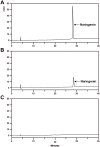Molecular and Biochemical Analysis of Chalcone Synthase from Freesia hybrid in flavonoid biosynthetic pathway
- PMID: 25742495
- PMCID: PMC4351062
- DOI: 10.1371/journal.pone.0119054
Molecular and Biochemical Analysis of Chalcone Synthase from Freesia hybrid in flavonoid biosynthetic pathway
Abstract
Chalcone synthase (CHS) catalyzes the first committed step in the flavonoid biosynthetic pathway. In this study, the cDNA (FhCHS1) encoding CHS from Freesia hybrida was successfully isolated and analyzed. Multiple sequence alignments showed that both the conserved CHS active site residues and CHS signature sequence were found in the deduced amino acid sequence of FhCHS1. Meanwhile, crystallographic analysis revealed that protein structure of FhCHS1 is highly similar to that of alfalfa CHS2, and the biochemical analysis results indicated that it has an enzymatic role in naringenin biosynthesis. Moreover, quantitative real-time PCR was performed to detect the transcript levels of FhCHS1 in flowers and different tissues, and patterns of FhCHS1 expression in flowers showed significant correlation to the accumulation patterns of anthocyanin during flower development. To further characterize the functionality of FhCHS1, its ectopic expression in Arabidopsis thaliana tt4 mutants and Petunia hybrida was performed. The results showed that overexpression of FhCHS1 in tt4 mutants fully restored the pigmentation phenotype of the seed coats, cotyledons and hypocotyls, while transgenic petunia expressing FhCHS1 showed flower color alteration from white to pink. In summary, these results suggest that FhCHS1 plays an essential role in the biosynthesis of flavonoid in Freesia hybrida and may be used to modify the components of flavonoids in other plants.
Conflict of interest statement
Figures







Similar articles
-
Molecular characterization and functional analysis of chalcone synthase from Syringa oblata Lindl. in the flavonoid biosynthetic pathway.Gene. 2017 Nov 30;635:16-23. doi: 10.1016/j.gene.2017.09.002. Epub 2017 Sep 7. Gene. 2017. PMID: 28890377
-
cDNA cloning and characterization of UDP-glucose: anthocyanidin 3-O-glucosyltransferase in Freesia hybrida.Plant Cell Rep. 2011 Jul;30(7):1209-18. doi: 10.1007/s00299-011-1029-7. Epub 2011 Feb 12. Plant Cell Rep. 2011. PMID: 21318353
-
Chalcone-Synthase-Encoding RdCHS1 Is Involved in Flavonoid Biosynthesis in Rhododendron delavayi.Molecules. 2024 Apr 17;29(8):1822. doi: 10.3390/molecules29081822. Molecules. 2024. PMID: 38675642 Free PMC article.
-
Elusive partners: a review of the auxiliary proteins guiding metabolic flux in flavonoid biosynthesis.Plant J. 2021 Oct;108(2):314-329. doi: 10.1111/tpj.15446. Epub 2021 Aug 11. Plant J. 2021. PMID: 34318549 Review.
-
Flower color modification by engineering of the flavonoid biosynthetic pathway: practical perspectives.Biosci Biotechnol Biochem. 2010;74(9):1760-9. doi: 10.1271/bbb.100358. Epub 2010 Sep 7. Biosci Biotechnol Biochem. 2010. PMID: 20834175 Review.
Cited by
-
Two Chalcone Synthase Isozymes Participate Redundantly in UV-Induced Sakuranetin Synthesis in Rice.Int J Mol Sci. 2020 May 27;21(11):3777. doi: 10.3390/ijms21113777. Int J Mol Sci. 2020. PMID: 32471084 Free PMC article.
-
Competition between anthocyanin and kaempferol glycosides biosynthesis affects pollen tube growth and seed set of Malus.Hortic Res. 2021 Aug 1;8(1):173. doi: 10.1038/s41438-021-00609-9. Hortic Res. 2021. PMID: 34333541 Free PMC article.
-
HMGR and CHS gene cloning, characterizations and tissue-specific expressions in Polygala tenuifolia Willd.PLoS One. 2024 Mar 25;19(3):e0300895. doi: 10.1371/journal.pone.0300895. eCollection 2024. PLoS One. 2024. PMID: 38527035 Free PMC article.
-
Gene Expression Analysis and Metabolite Profiling of Silymarin Biosynthesis during Milk Thistle (Silybum marianum (L.) Gaertn.) Fruit Ripening.Int J Mol Sci. 2020 Jul 2;21(13):4730. doi: 10.3390/ijms21134730. Int J Mol Sci. 2020. PMID: 32630801 Free PMC article.
-
Transcriptome-IPMS analysis reveals a tissue-dependent miR156/SPL13 regulatory mechanism in alfalfa drought tolerance.BMC Genomics. 2020 Oct 19;21(1):721. doi: 10.1186/s12864-020-07118-4. BMC Genomics. 2020. PMID: 33076837 Free PMC article.
References
-
- Maleka MF, Albertyn J, Spies JJ (2013) The floriculture industry and flower pigmentation. Philos Trans Genet 2: 55–110.
-
- Zhou XW, Fan ZQ, Chen Y, Zhu YL, Li JY, Yin HF (2013) Functional analyses of a flavonol synthase—like gene from Camellia nitidissima reveal its roles in flavonoid metabolism during floral pigmentation. J Biosci 38: 593–604. - PubMed
-
- Niyogi KK (2000) Safety valves for photosynthesis. Curr Opin Plant Biol 3: 455–460. - PubMed
Publication types
MeSH terms
Substances
LinkOut - more resources
Full Text Sources
Other Literature Sources
Molecular Biology Databases

